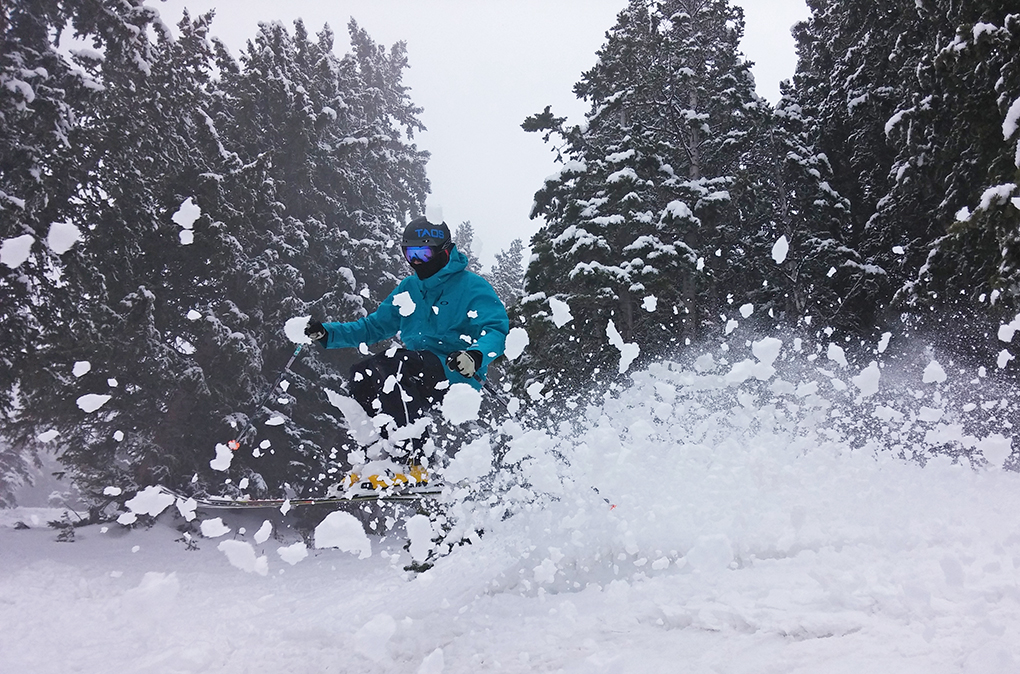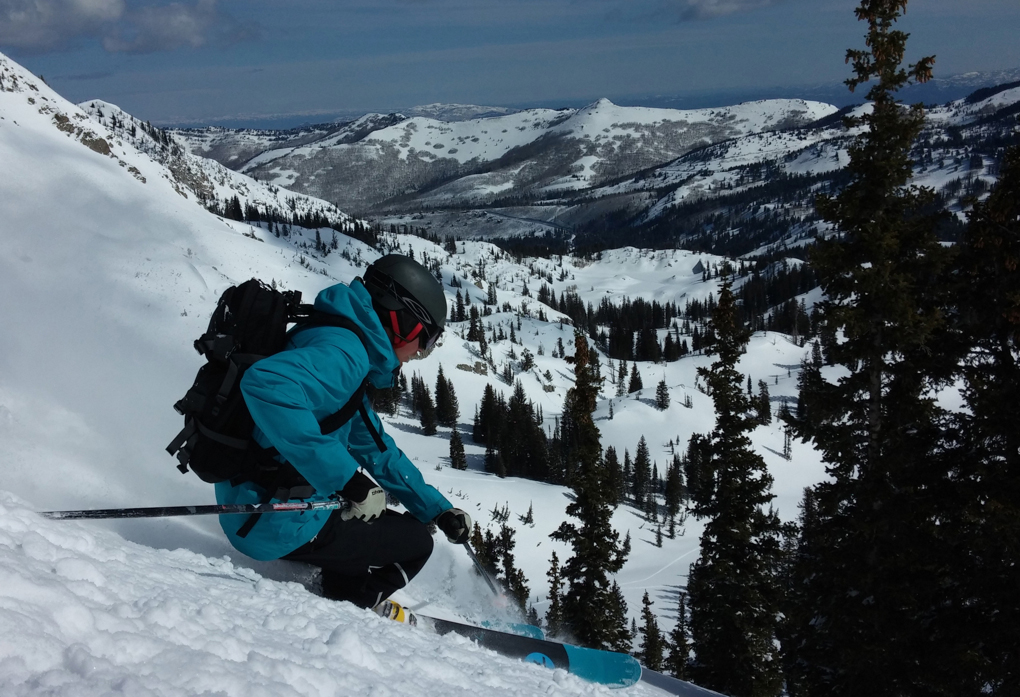
Oakley Drifter Jacket
Size Tested: Extra Large
Reviewer: 6’, 160 lbs.
Fit: Regular
Color: Enamel Blue
Front Zipper Length: 32”
Blister’s Measured Weight: 955 grams
Features:
- Shell: 100% Polyester
- Oakley Hydrogauge™ 20 waterproof/breathable laminate
- OOR™ Hood, cuff, and drop tail
- Goggle Squeegee and google cloth
- Spare lens pocket
- Detachable Storm Skirt
- Taped seams
- Wrist gaiters
- 17” Underarm vents
- Touch friendly phone/mp3 pocket
- Goggle pouch
Test Locations: Alta Ski Area, Alta backcountry, Park City Mountain Resort
Test Duration: 13 days
MSRP: $360.00
I have tested three jackets from Oakley over the course of the 13/14 season: the Oakley Cottage, the Drifter (the focus of this review), and the Beltline Pro.
Since Oakley produces a wide range of outerwear, we wanted to review products from various price points within the line, identify the strengths and limitations of each jacket, and compare their proprietary laminates to jackets from some other brands (The North Face, Burton, and Eastern Mountain Sports).
Membrane & (Kickass) Design Features
The Drifter Jacket uses the best of Oakley’s three proprietary membranes: Hydrogauge 20. This fully taped 3-layer fabric boasts a waterproof rating of 20,000mm and a breathability rating of 15,000g/m2/24hr. In contrast, the less expensive, insulated Cottage uses Oakley’s 2-layer Hydrogauge 15 material (15,000mm / 10,000g/m2/24), and the Beltline Pro (review forthcoming) uses Gore-Tex Pro Shell (27,000mm / 20,000g/m2/24hr).
Notable features on the Drifter include a goggle squeegee, goggle cloth, and devoted spare lens pocket, which are all found on the three other Oakley jackets mentioned. These are very simple features that are surprisingly and unfortunately absent on many jackets today. I use all of these features regularly to remove rime, wet snow and slush, or to swap out lenses to accommodate changing light conditions.
Another feature I think all ski and snowboard jackets should have, and that is found on the Drifter, are wrist gaiters. The gaiters on the Drifter fit around my hand well, and perform just as they are supposed to. They prevent snow and cold air from entering the jacket with gloves on or off, or while tomahawking down the mountain.
Lastly, a handy little feature of the Drifter is the see-through, touchscreen friendly internal phone pocket, which is also found on the Cottage (see my Cottage review for a more in-depth look at the pocket).

Fit
It seems Oakley made alterations to their “Regular” fit for 2014. Compared to the XL Unification Pro jacket I tested last season, which also is a Regular fit, the Drifter Jacket is smaller all around.
Last year, I found the fit of the Unification Pro to be a little slim, though well suited for touring/backcountry skiing. It provided enough room for restriction-free movement without being unnecessarily bulky. The new regular fit does have a drop tail hem and an extended cuff around the neck, but while these changes do help increase coverage, the shortened sleeve and torso length of the Drifter were a bit of a problem for me. The jacket doesn’t seem to provide me with the same range of motion, especially through the sleeves, which also caused the gaiters to feel a bit uncomfortable at times.
Comparing the XL Drifter to my XL jackets from The North Face, Scott, Burton, and EMS, I would say it feels about one size smaller in every way—except when it comes to torso width, where it seems about the same.
The Drifter jacket was still somewhat comfortable thanks to its very stretchy polyester face fabric. But still, tall, slender folks will likely prefer the Oakley’s Loose Fit, while shorter individuals may find the updated Regular fit more appealing.
Waterproofing
The Drifter has kept me dry in every condition I’ve encountered so far. With a 20,000mm waterproof rating, I don’t imagine I’ll ever overwhelm this jacket in the high desert mountains of Utah.

Warmth
The Drifter is a thin, uninsulated 3-layer shell, so proper layering is required to keep warm in cold conditions. The Hydrogauge 20 fabric seems to perform about the same as a 3-layer jacket with Gore-Tex Performance Shell, but, as I’ll explain below, doesn’t breathe quite as well as a jacket with 3-layer Gore-Tex Pro Shell (like the Unifications Pro and Beltline Pro).
With a heavy down insulator (Scott Kickstart) under the Drifter, I have been comfortable resort skiing with temperatures in the low teens. Above freezing at the resort or in temperatures as low as 20° F while touring, I have been happiest with a lighter insulator under the Drifter, such as the Scott Komati or Decoder.
Breathability & Venting
I have been impressed with the breathability of Oakley’s proprietary Hydrogauge 20 membrane. It’s breathability seems on par with 3-layer Gore-Tex Performance Shell fabric used in similarly priced and slightly more expensive jackets. For resort riding, the Drifter has adequately regulated temperature with ample breathability. The jacket has 17” pit zips for venting, which easily dump excess heat when opened in conjunction with its front zipper.
The Hydrogauge 20 fabric, however, doesn’t seem to quite match the breathability of 3-layer Gore-Tex Pro Shell fabric on strenuous backcountry days, especially when touring in direct sunlight.
Durability
The Drifter currently looks as good as the day it arrived, apart from the little loop of fabric used to hang the jacket, which ripped out (thread failure) early in the test. The loop failure did not damage the shell in any way. Other than that, I can’t say I’ve noticed any signs that suggest the jacket is likely to have durability issues. I’ll update this section if any significant problems do arise.
Hydrogauge 20 vs. Hydrogauge 15
Most of Oakley’s jackets with Hydrogauge 20 fabric are around $100 more expensive than those made with Hydrogauge 15. Choosing a piece with Hydrogauge 20 provides you with a product that is at least as waterproof and windproof as Hydrogauge 15, but that breathes better and allows for easier temperature regulation—on par with jackets with 3-layer Gore-Tex Performance Shell (though not quite as breathable as Gore’s 3-layer Pro-Shell material). The 3-layer Hydrogauge 20 fabric jacket is also much lighter and more packable, given the absence of the insulating liner in Hydrogauge 15. So when does it make sense to spend the extra cash on a jacket with Hydrogauge 20?
If you (1) don’t plan on doing any backcountry skiing, (2) don’t plan on doing much bootpacking in the resort, and (3) don’t need a jacket for warm, late-season spring conditions, the breathability of a jacket with Hydrogauge 15 (like the Cottage) will likely be sufficient. If you do plan on skinning, hiking, and need a more packable piece, then it would definitely make sense to spend a bit more for a shell with Hydrogauge 20 (like the Drifter).
Bottom Line
If you’re happy with the cut and style of the Drifter, it is a versatile shell that is great for skiing inbounds and in the backcountry. And if you’re not a fan of the fit the Drifter, then give some consideration to other Oakley jackets with Hydrogauge 20 fabric. The material performs very well, is very comfortable thanks to its slight stretch, and offers a level of performance on par with jackets with 3-layer Gore-Tex Performance Shell at a competitive price.
